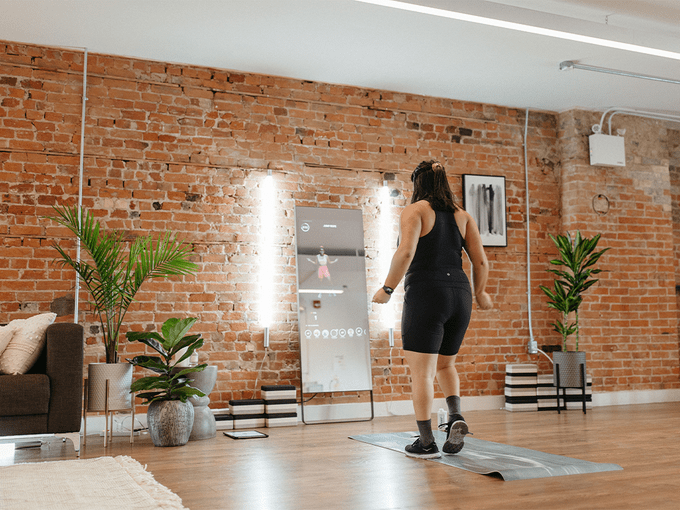Is Lululemon’s MIRROR Worth Its Steep Price Tag?
I tried this buzzy high-tech workout device to see if it could transform my at-home exercise routine. Here’s what happened.
It can be hard to stay motivated and active in the colder months, especially when the pandemic has forced many of us to exercise at home. In the Before Times, I loved going to IRL fitness classes—I’ve tried everything from Yin Yoga to Pound (a cardio workout where you pretend to be a drummer in a rock band; I highly recommend it). When COVID forced me to turn a 2 by 2 metre section of my living room into my home gym, my activity level dropped exponentially. So, when I got the chance to try MIRROR, a fitness brand and product now owned by Lululemon, I jumped at the chance.
MIRROR launched earlier this year in the States, and the product (and its app) is arriving in Canada on November 22 this year. Marketed as a “nearly invisible, smart home gym,” MIRROR is part-normal mirror, part-TV screen, and nothing like other at-home gym options as it takes up zero floor space—you can hang it up or lean it against a wall. Plus, while a spin bike stays a spin bike (or, something to toss dirty laundry on) MIRROR is just a normal mirror whenever you aren’t working out with it making it a functional option for people with small living spaces. However, the price is sky-high: the normal base price of the device is $1895, then you pay $49 monthly for access to classes. For comparison, the basic Peloton and an all-access membership for its app costs the same.
(Related: Can Apple Fitness+ Change Your At-Home Workout Game?)
I tried MIRROR at the Lululemon flagship store in Toronto, and it looked like something straight out of Black Mirror. Through its sleek, thin screen, I could see both my own reflection and a scrolling display of workout classes and community-member chatter. I also noticed that there was a camera in the device, which can be turned on for live classes so the instructor can see you. Thankfully, MIRROR comes with a camera cover (so it can’t creepily watch me sleep—my deep-seated personal fear).
Once I started working out, the sci-fi-ness faded into the back of my mind. The mobile app that accompanies and controls MIRROR is similar to the Nike app, and asks for a bunch of personal details (age, skill level, goals and any limitations you have, like injuries). It will then offer workout modifications at the bottom left corner of the screen to make the class more appropriate to you. Plus, as you use MIRROR, it will start to suggest classes based on your preferences as it gets to know you (okay, this part is VERY Black Mirror). You can also connect any Bluetooth fitness tracker, like your Apple Watch or FitBit, so it can measure your heart rate and calories burnt.
MIRROR’s catalogue of classes is massive, with 50 different categories including yoga, dance, cardio, Tai Chi, pre- and postnatal workouts, ballet, Pilates and more. Classes range from five to 60 minutes, and you can choose from four difficulty levels, many of which can be done with no equipment (though some do incorporate kettlebells and weights).
(Related: I Need You to Know: Fitness Is Not One Size Fits All)


On top of the on-demand classes, MIRROR members can join live classes. If you choose to turn your camera on, your instruction can see you and shout you out. Or, if you love competition, you can join a Competitive Class where you earn points when you hit your target heart rate. And, if you crave one-on-one time, MIRROR also offers personal training sessions at $40 a pop.
For my demo, I decided to try a 15-minute cardio class. I twisted my ankle the weekend prior, so I picked a class that didn’t include jumps or other injury-aggravating moves—info that the class description gave me right off the bat, which I appreciated. Despite choosing “level 1,” an absolute beginner class, it immediately got my heart pumping and glutes burning (no jumps meant lots of side lunges).
I thought that I’d be self-consciously peering at myself during the whole workout, but instead I found it intuitive to concentrate on the instructor and wasn’t at all distracted by my out-of-focus reflection during the peak of the class. When I moved on to the cooldown (a 15-minute slow, restorative Yin yoga flow class) though, I did catch myself watching my reflection instead of connecting to my breath.
Despite how sleek (and admittedly, cool) MIRROR is, my favourite part of the product has nothing to do with the hardware itself. I absolutely loved the accompanying app—the huge variety of classes, how much you could modify and customize workouts and the trainers’ great energy. I think I could’ve gotten an equally good workout with the app’s video playing over my TV (and, luckily, you can stream MIRROR classes to your TV using a compatible casting device like Apple TV or Chromecast, though it’s unclear which functionalities disappear without the hardware).
That being said, when compared to other similarly priced fitness gadgets like a Peloton, MIRROR is a much more compact device with way more class options to pick from—giving it an edge over comparable workout systems. All in all, I think I’ll try out the MIRROR app and broadcast it to my Apple TV to get the best of MIRROR without the Black Mirror vibes.
Lululemon MIRROR, $1895, launches November 22.
Next: 4 Stretches to Improve Range of Motion as You Age
Popular Videos
